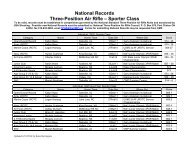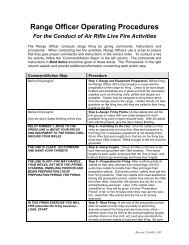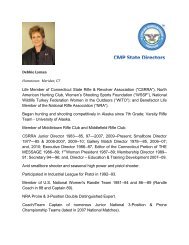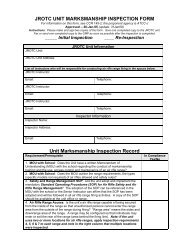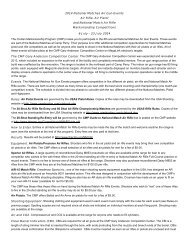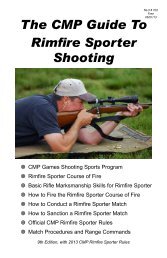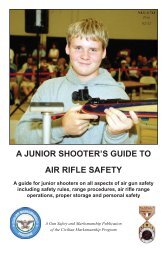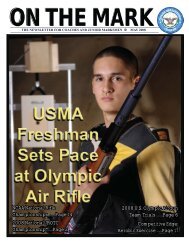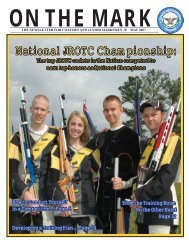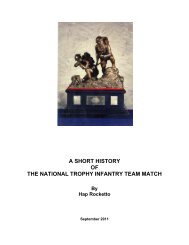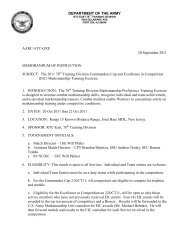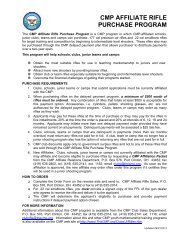summer 2010 - Civilian Marksmanship Program
summer 2010 - Civilian Marksmanship Program
summer 2010 - Civilian Marksmanship Program
You also want an ePaper? Increase the reach of your titles
YUMPU automatically turns print PDFs into web optimized ePapers that Google loves.
convertible to greet my grandmother who was<br />
sitting in a wheelchair along the road. They<br />
exchanged a really big hug,” she recalled,<br />
emotionally.<br />
Mrs. Anderson discussed the many exciting<br />
events in their lives including Anderson’s<br />
presentation of the first Distinguished<br />
International Shooter Badge by President John<br />
F. Kennedy in the Oval Office in 1963, a second<br />
gold medal in Mexico City in 1968, his Masters<br />
of Divinity degree, his term as a Nebraska State<br />
Senator, his appearance on the television show<br />
To Tell The Truth and their many travels abroad.<br />
“We have a wonderful life. We have raised<br />
extraordinary children. We have the brightest<br />
and most adorable grandchildren,” she said.<br />
“Gary is a multi-tasker, he does not waste<br />
time - ever. He does not watch movies and he<br />
does not play games. He has little tolerance for<br />
negativity or things not intuitive,” she said.<br />
The Andersons will be spending more<br />
time with family and they are interested in<br />
supporting the creation of a Shooting Sports<br />
Museum. Future travel plans include more<br />
tours of Germany - a favorite destination, she<br />
added.<br />
“We have an abundance of friends from<br />
all over the world. We have had phenomenal<br />
travel experiences and we enjoy good health,”<br />
she said. “God has richly blessed us.”<br />
Anderson gave closing remarks about his<br />
upbringing, shooting career and his interests in<br />
furthering the development of shooting sports<br />
at home and abroad.<br />
With the help of his father, who taught him<br />
to hunt birds and small game on their farm,<br />
Anderson sponged up every bit of shooting<br />
knowledge he could absorb and melded it with<br />
countless hours of self-driven practice.<br />
Growing up in Nebraska with no shooting<br />
aids, no coaches and very little ammunition,<br />
his drive to become a world-class marksman<br />
overcame all of those obstacles.<br />
Ruth Ann and Gary with their daughter,<br />
Kirsten.<br />
Since the USSR was dominating shooting<br />
sports in international competition in the 1950s,<br />
he modeled his training after Russian champ<br />
Anatoli Ivanovich Bogdanov, who credited<br />
dry-firing as one of the most important parts<br />
of rifle training.<br />
“The dream of becoming as good as<br />
Bogdanov inspired me,” Anderson said, in<br />
spite of rising political tensions between the<br />
US and Soviet Union during the Cold War.<br />
Anderson said Bogdanov was “the greatest<br />
shooter in the world,” whose accomplishments<br />
included Olympic gold medals in threeposition,<br />
300 meter free rifle in Helsinki,<br />
Finland in 1952 and the 50 meter smallbore<br />
free rifle in Melbourne, Australia in 1956.<br />
“The importance of dry-firing resonated<br />
very well with me because I didn’t have the<br />
money to buy bullets,” Anderson said. “I<br />
improvised and went to work and things began<br />
to come together for me.”<br />
“I came to the conclusion though, that the<br />
only real way I could realize my dreams was<br />
to get to the Army <strong>Marksmanship</strong> Unit,” he<br />
explained.<br />
He said he solicited a tryout with the AMU,<br />
penning a letter and submitting sample scores<br />
to then Col. Thomas Sharpe, the head of, and<br />
considered by many, the founder of USAMU.<br />
Though many speculated that Anderson’s<br />
scores couldn’t be trusted, Col. Sharpe “for<br />
some, yet unknown reason” granted Anderson<br />
a 90-day trial, he said.<br />
After 30 days of dry-firing, he was allowed<br />
to fire a 40-shot standing match and his score,<br />
the second best in the unit that day, sealed his<br />
AMU assignment.<br />
Anderson then posed a few hypothetical<br />
questions to the gathering: “What if I had<br />
been a member of a regular shooting club,<br />
with a regular coach or instructor where my<br />
model would have been the best shooter in<br />
the club What would have happened to Gary<br />
Anderson”<br />
“How would shooting history been<br />
different if Col. Tom Sharpe had decided that<br />
this kid was lying and hadn’t given me a tryout<br />
with the unit History sometimes depends on<br />
those kinds of decisions.”<br />
He answered his final question by describing<br />
what it was like to make the transition from<br />
a competition shooter to a career of devoting<br />
his efforts to serving shooters and the sport of<br />
shooting, like he had for the last 10 years at<br />
CMP.<br />
“To be a champion, your egos have to<br />
be totally focused on ‘Me.’ To be a teacher, a<br />
sports administrator, a coach - to be a leader,<br />
your ego has to be totally focused on ‘You.’ “<br />
Anderson said he has “very vivid memories<br />
of being blown off by many experienced<br />
JUNE <strong>2010</strong> 5<br />
Gary talking to his dad on the farm in Nebraska.<br />
shooters who told me to figure it out for myself”<br />
when he was a young competition shooter on<br />
the Army International Shooting Team.<br />
“The culture then was not one of sharing<br />
information with new shooters,” he said.<br />
But he credited three mentors who made<br />
a huge impact on his ability to transition<br />
when the time came - International Rifle<br />
Coach Bill Krilling, 1964 Olympic 300 meter<br />
bronze medalist Martin Gunnarrson and world<br />
champion pistol shooter Bill Blankenship - all<br />
of whom answered his questions and made a<br />
very deep impression on him.<br />
“I swore to myself that if I ever did make<br />
it to the top, I would do my best to share what<br />
I had learned.” He also said it always gratifies<br />
him to see young people reach their goals in<br />
shooting - he said it’s as rewarding as all the<br />
medals he’s won in competition.<br />
In the end, Anderson thanked his wife, the<br />
CMP Board, its staff and the shooting sports<br />
community for making his career at CMP at<br />
success.<br />
“No one ever does anything great alone.<br />
Our quest at CMP has always been one of “we”<br />
not “me,” he added.<br />
The reality is “retirement” is a word that<br />
can’t be found in Anderson’s lexicon - at<br />
least not one that applies to him. He hit the<br />
marksmanship accelerator as a youngster<br />
growing up on a farm in Axtell and hasn’t let<br />
off - and he shows no signs of doing so anytime<br />
soon.<br />
“Retirement is a negative concept to me.<br />
There’s still a lot of work to be done in shooting<br />
sports and I will do my share,” he said.<br />
Today Anderson serves a DCM Emeritus<br />
where he will provide occasional instruction<br />
and consulting. He will remain busy in the US<br />
and abroad as Vice President of the International<br />
Shooting Sports Federation (the first American<br />
to serve in that capacity) and as President of the<br />
Board of USA Shooting.




